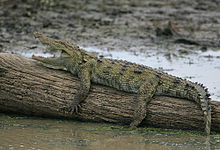- Crocodylus palaeindicus
-
Crocodylus palaeindicus
Temporal range: Miocene–PleistoceneScientific classification 
Kingdom: Animalia Phylum: Chordata Class: Reptilia Superorder: Crocodylomorpha Order: Crocodylia Family: Crocodylidae Genus: Crocodylus Species: †C. palaeindicus Binomial name Crocodylus palaeindicus
Falconer, 1859Synonyms - Crocodylus sivalensis Lydekker, 1886
Crocodylus palaeindicus is an extinct species of crocodile from southern Asia. C. palaeindicus lived from the Miocene to the Pleistocene. It may be an ancestor of the living Mugger crocodile.
History
C. palaeindicus was first named by Scottish paleontologist Hugh Falconer in 1859. Falconer found fossils of the species in the Siwalik Hills of India along with the remains of many other animals like turtles, ostriches, camels, saber-toothed cats, mastodons.[1] Richard Lydekker later named another crocodile from the Siwalik Hills which he called C. sivalensis. Although the two crocodiles are very similar, C. sivalensis was distinguished from C. palaeindicus because the margin of its skull was less convex. C. sivalensis has recently been synonymized with C. palaeindicus, as the slight differences in shape are thought to be from natural variation or from fossilization.[2] In later years, fossils were also found from Pakistan and Myanmar.
Classification
 The Mugger crocodile, a close relative and possible descendant of Crocodylus palaeindicus
The Mugger crocodile, a close relative and possible descendant of Crocodylus palaeindicus
Historically, C. palaeindicus was considered a direct ancestor of the Mugger crocodile C. palustris. The two species are similar in appearance, and some fossils of C. palustris were at first mistaken for C. palustris.[2] Most modern phylogenetic analyses of crocodiles place C. palaeindicus in a basal position among members of the genus Crocodylus; only the living Slender-snouted crocodile C. cataphractus is more basal, although it may belong to a distinct genus, Mecistops. Recent studies place it in a polytomy, or unresolved relationship, with two large groups: the neotropical and African crocodiles and the Indopacific crocodiles. The extinct African species Crocodylus anthropophagus is also part of this polytomy. Below is a cladogram modified from Brochu et al. (2010) showing the relation of C. palaeindicus with other crocodiles:[3]
Crocodylidae Tomistominae
Crocodylinae Osteolaeminae
Crocodylus niloticus
New World crocodiles Crocodylus acutus
Crocodylus intermedius
Crocodylus rhombifer
Crocodylus moreletii
†Crocodylus palaeindicus
Crocodylus palustris
Indopacific crocodiles Crocodylus siamensis
Crocodylus porosus
Crocodylus johnstoni
Crocodylus novaeguineae
Crocodylus mindorensis
References
- ^ Lydekker, R. (1885). Catalogue of the remains of Siwalik Vertebrata contained in the Geological Department of the Indian Museum, Calcutta. 1. Superintendent of Government Printing, India. http://books.google.com/books?id=zgoAAAAAQAAJ&printsec=frontcover#v=onepage&q&f=false.
- ^ a b Brochu, C. A. (2000). "Phylogenetic relationships and divergence timing of Crocodylus based on morphology and the fossil record". Copeia 2000 (3): 657–673.
- ^ Brochu C. A., Njau J., Blumenschine R. J., Densmore L. D. (2010) "A New Horned Crocodile from the Plio-Pleistocene Hominid Sites at Olduvai Gorge, Tanzania. PLoS ONE 5(2): e9333. doi:10.1371/journal.pone.0009333
Categories:- Crocodylidae
- Neogene crocodylomorpha
- Prehistoric reptiles of Asia
Wikimedia Foundation. 2010.
